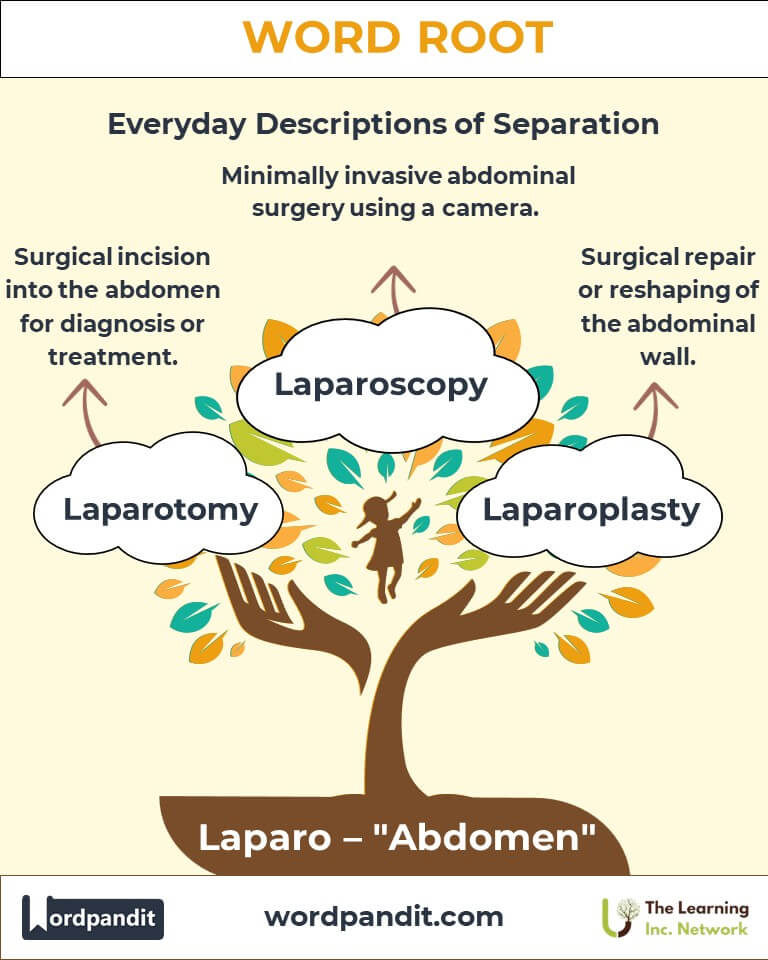Laparo: The Root of Exploration in Medicine and Beyond
Discover the fascinating world of the root "laparo," derived from the Greek word for "flank" or "soft part of the abdomen." This root has shaped medical terminology, particularly in minimally invasive surgical procedures. From laparoscopy to laparotomy, the "laparo" root highlights innovation and precision in healthcare.

Table of Contents
- Introduction: The Significance of Laparo
- Etymology and Historical Journey
- Mnemonic: Unlocking the Power of Laparo
- Common Laparo-Related Terms
- Laparo Through Time
- Laparo in Specialized Fields
- Illustrative Story: Laparo in Action
- Cultural Significance of Laparo
- The Laparo Family Tree
- FAQs about the Laparo Word Root
- Test Your Knowledge: Laparo Mastery Quiz
- Conclusion: The Living Legacy of Laparo
1. Introduction: The Significance of Laparo
The word root "laparo," pronounced lah-puh-roh, originates from the Greek word lapara, meaning "flank" or "abdomen." This root has become foundational in medical language, particularly in surgical terminology. It underscores humanity's progress in understanding and accessing the human body with precision and care.

2. Etymology and Historical Journey
The root "laparo" traces its origins to ancient Greek medicine, where lapara referred to the abdomen's soft regions. Over centuries, as surgical practices advanced, the term evolved to represent procedures targeting the abdominal cavity. The invention of laparoscopic techniques in the 20th century revolutionized surgery, cementing "laparo" as a symbol of innovation and less invasive approaches.
3. Mnemonic: Unlocking the Power of Laparo
Imagine a surgeon holding a tiny camera, peering into the abdomen with remarkable clarity. This visualization reflects the root's connection to abdominal exploration.
Mnemonic Device: “Laparo leads the way to less invasive abdominal surgery.”
4. Common Laparo-Related Terms
- Laparoscopy (lah-puh-ros-kuh-pee): A minimally invasive surgical procedure using a camera to examine the abdomen.
Example: "The doctor performed a laparoscopy to diagnose the patient’s abdominal pain." - Laparotomy (lah-puh-rot-uh-mee): A surgical incision into the abdomen for diagnostic or therapeutic purposes.
Example: "The laparotomy allowed surgeons to remove the patient’s appendix safely." - Laparoscope (lah-puh-roh-skohp): A slender instrument equipped with a camera for viewing the abdominal cavity.
Example: "The laparoscope provided a clear view of the patient’s internal organs." - Laparoplasty (lah-puh-roh-plas-tee): A surgical procedure to repair or reshape the abdominal wall.
Example: "Laparoplasty helped restore function after an injury to the abdomen." - Laparocele (lah-puh-roh-seel): A hernia in the abdominal region.
Example: "The patient was treated for a laparocele with minimally invasive techniques."
5. Laparo Through Time
- Ancient Origins: Early references to abdominal surgeries in ancient texts, though rudimentary, set the stage for modern laparo-related terms.
- Modern Revolution: The development of laparoscopic tools in the late 20th century marked a turning point, transitioning from open surgeries (laparotomy) to minimally invasive procedures (laparoscopy).
6. Laparo in Specialized Fields
- Surgery: Laparoscopic procedures are standard for gallbladder removal, hernia repair, and more.
Example: "Surgeons often prefer laparoscopy for quicker recovery times." - Gynecology: Laparoscopy assists in diagnosing and treating endometriosis and ovarian cysts.
Example: "The gynecologist recommended laparoscopy to investigate unexplained pelvic pain." - Oncology: Tumor resections in the abdomen often use laparoscopic techniques for minimal trauma.
Example: "Laparoscopy allowed for precise removal of the abdominal tumor."
7. Illustrative Story: Laparo in Action
Dr. Elena, a pioneer in laparoscopic surgery, was called upon to save a patient with a life-threatening abdominal injury. Using a laparoscope, she navigated the complex internal structures with precision, avoiding a full laparotomy. The patient recovered swiftly, marveling at the tiny scars left by the procedure. Dr. Elena’s expertise showcased the power of "laparo" in advancing modern medicine.
8. Cultural Significance of Laparo
The rise of laparoscopy has redefined how society views surgery, emphasizing minimalism and efficiency. This shift reflects broader cultural values of precision and technological integration, inspiring advancements in medical training and patient care.

9. The Laparo Family Tree
- Gastro- (stomach):
Example: Gastroscopy: Examination of the stomach using an endoscope. - Entero- (intestines):
Example: Enteroscopy: Imaging of the small intestine. - Celio- (abdomen):
Example: Celiotomy: Surgical incision into the abdominal cavity.
FAQs About the Laparo Word Root
Q: What does "laparo" mean?
A: "Laparo" is derived from the Greek word lapara, meaning "flank" or "abdomen." It is commonly used in medical terminology related to the abdominal cavity.
Q: What is the difference between laparoscopy and laparotomy?
A: Laparoscopy is a minimally invasive surgery using a laparoscope through small incisions, while laparotomy involves a large incision to directly access the abdominal cavity.
Q: Why is laparoscopy often preferred?
A: Laparoscopy reduces scarring, recovery time, and infection risks compared to traditional open surgery, making it the preferred choice for many abdominal procedures.
Q: What is a laparoscope, and how does it work?
A: A laparoscope is a thin, camera-equipped instrument that provides real-time images of the abdominal cavity, guiding surgeons during minimally invasive procedures.
Q: Can all abdominal surgeries be performed laparoscopically?
A: No. While many surgeries can be done laparoscopically, complex cases like large tumors or severe trauma may require laparotomy for better visualization and access.
Test Your Knowledge: Laparo Mastery Quiz
1. What does the root "laparo" mean?
2. Which procedure uses small incisions and a camera?
3. What is a laparoscope?
4. Which term describes a surgical incision into the abdomen?
5. What does laparocele refer to?
12. Conclusion: The Living Legacy of Laparo
The root "laparo" has profoundly impacted medical science, symbolizing precision, innovation, and care. From ancient abdominal surgeries to modern laparoscopic techniques, it represents humanity's drive to heal and improve. As technology advances, the legacy of "laparo" will continue to evolve, shaping the future of medicine and patient care.












